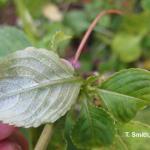Impatiens Downy Mildew in Home Gardens
Impatiens downy mildew Plasmopara obducens is a new disease for home gardeners in Massachusetts. Impatiens downy mildew was first diagnosed on Impatiens (walleriana) in landscapes in Massachusetts in 2011. The disease appeared again in 2012. In 2011, it was also reported in CA, IL, IN, NY, MN and WI and in January 2012 downy mildew was seen on landscape impatiens in Florida.
Symptoms
Downy mildew symptoms on Impatiens walleriana typically start with a few leaves that appear slightly yellow or off color (not to be confused with lack of fertilizer), and become completely yellow over time. Leaves may curl downward as if they need to be watered. Under humid conditions, a white, downy-like growth develops on the underside of primarily yellow or curled leaves, but can also be found on the underside of green leaves. Sometimes it is difficult to see the spores without a magnifying glass or hand lens. Eventually the leaves and flowers will drop, resulting in bare stems with only a few tiny, yellow leaves remaining. These stems can become soft and the plant collapses, similar to frost damage.
Which plants get this disease?
This is a disease that affects all Impatiens walleriana plants (garden impatiens, including double impatiens and mini-impatiens, Fusion® and Butterfly® impatiens and I. balsamina (commonly known balsam impatiens). It reportedly also affects some native wild impatiens, I. pallida and I. capensis, known as jewelweeds. Research is currently underway at UMass to determine if this is true. New Guinea impatiens (I. hawkeri) including SunPatiens® and all other bedding plants are not affected.
Favorable Environmental Conditions
Impatiens downy mildew is highly influenced by the weather.
- Wet foliage, cool temperatures (especially at night), and moist air are ideal conditions for disease development.
Downy mildew requires moisture to create spores and cause new infections. Plants in heavily shaded locations where the leaves stay wet for extended periods of time will generally have a higher incidence and severity of disease because moisture promotes infection and disease development.
Impatiens down mildew tends to be worse in:
- Locations where leaves stay wet for extended periods of time (4 hours or longer).
- Very dense plantings – plants spaced close together.
- Gardens receiving overhead irrigation, because the foliage does not dry quickly.
How It Spreads
Downy mildew can be spread short distances by water splashing from infected plants and greater distances by windborne spores from infected plants in nearby landscapes.
Two types of spores are produced that can initiate disease infection:
- Short-lived (dispersal) spores produced in the white downy-like growth on the undersides of infected leaves. These spores will not overwinter but will spread the disease by blowing in wind currents.
- Resting (survival) spores produced inside infected stems and leaf petioles (part that attaches to the stem). These resting spores, called oospores, release into the soil from infected plants debris where they can survive and potentially initiate new infections on Impatiens walleriana planted into the same garden beds for many years.
Impatiens downy mildew can occur in beds with no history of the disease if wind-dispersed spores blow in from other locations.
Can Infected Plants Be Saved?
Once plants are infected they will not recover. Fungicide applications by home gardeners are not recommended since effective fungicides are not available to home gardeners. Fungicide applications are best left for professional landscapers. Fungicides with activity for downy mildew might offer short-term protection for healthy plants only. Fungicides would need to be reapplied throughout the season to keep healthy plants protected and there are no guarantees it will work. Infected plants that are trimmed back will not recover even if a fungicide is used. The disease is inside the plant.
What to Do With Infected Plants
Plants with this disease should be removed, roots, soil and all, bagged and destroyed. Do not compost infected plants or depend on fungicides. If left in the garden, there is a high risk that this disease will overwinter and infect impatiens in future years.
End of season management:
- Inspect Impatiens walleriana plants for this disease.
- Remove infected plants and leaf debris.
- Note which garden beds or areas harbored diseased plants.
- End of season fungicide applications are not recommended.
Future Plantings
Impatiens walleriana replanted into beds with a history of impatiens downy mildew are at a higher a risk of infection than Impatiens walleriana planted into beds with no history of the disease. The downy mildew infecting impatiens attacks only Impatiens walleriana therefore, it safe to plant other flowering or foliage plants in affected beds next season.
- Alternative shade-loving plants including New Guinea impatiens (Impatiens hawkeri), begonias, torenia and coleus can be safely planted in beds with a history of impatiens downy mildew. (Coleus is susceptible to a different downy mildew disease, but the downy mildew species that infects Impatiens walleriana cannot infect coleus.)
Disclaimer
The most reliable information was included that was available at time this information was compiled. Due to constantly changing laws and regulations, UMass Extension can assume no liability for recommendations. The pesticide user is always responsible for the effects of pesticide residues on their own crops, as well as problems caused by drift from their property to other properties or crops. Always read and follow all instructions on the label.


